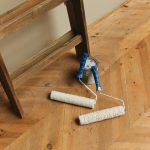Yes, you can absolutely iron clothes when they’re slightly damp to effectively remove wrinkles. The moisture helps with heat distribution, making it easier to achieve that crisp finish. Plus, it can save you time and reduce the risk of fabric damage. Just make sure to adjust the iron temperature according to the fabric type and avoid over-ironing to prevent shiny spots. For more tips on techniques and tools, there’s plenty more to discover.
Table of Contents
Key Takeaways
- Ironing slightly damp clothes effectively removes wrinkles and saves time compared to dry ironing.
- Moisture in the fabric aids in heat distribution, enhancing wrinkle removal.
- Always check fabric care labels to ensure suitability for damp ironing.
- Adjust the iron’s temperature based on the fabric type for optimal results.
- Using steam can further improve wrinkle release during the ironing process.
Benefits of Ironing Damp Clothes
When you iron damp clothes, you not only make wrinkles disappear but also save time and effort. The moisture in the fabric helps the heat from the iron work more effectively, allowing you to glide over wrinkles with ease. This method can reduce the need for excessive steaming or additional products, streamlining your ironing process.
Additionally, ironing damp clothes can help set the fabric’s shape, ensuring a crisp finish that lasts longer. You’ll also find that this technique can prevent overheating, which can damage delicate fabrics.
Techniques for Effective Damp Ironing
When it comes to damp ironing, getting the details right makes all the difference.
You’ll want to choose the ideal iron temperature, use steam effectively, and guarantee you’re working with suitable fabrics.
Let’s explore these techniques to achieve smooth, wrinkle-free results.
Optimal Iron Temperature
Finding the right iron temperature is crucial for effectively damp ironing your clothes. When your garments are slightly damp, aim for a medium to high setting, depending on the fabric type.
For cotton and linen, a higher temperature works best, while synthetics like polyester require a lower setting to prevent damage. Always check the care label for specific temperature recommendations.
Before you start, test the iron on a hidden area to verify it’s not too hot. If the fabric starts to shine or scorch, lower the temperature immediately.
Remember, a steady hand and smooth strokes help avoid creating new wrinkles, so take your time to glide the iron over the fabric for the best results.
Happy ironing!
Use of Steam
Using steam can greatly enhance your damp ironing experience. When you use a steam iron, the moisture penetrates the fabric, making it easier to smooth out wrinkles.
Start by filling your iron’s water reservoir and setting it to the appropriate temperature based on your fabric type. As you iron, activate the steam function regularly, allowing the hot steam to work its magic on the damp fabric.
This technique helps relax the fibers, resulting in crisp, wrinkle-free clothing. Move your iron slowly and evenly, letting the steam do the hard work. If you notice stubborn wrinkles, hold the steam button for a few seconds directly on the area.
This added moisture guarantees a smooth finish without excessive heat damage.
Suitable Fabrics Only
While not all fabrics respond well to damp ironing, understanding which materials are suitable can make a significant difference in your results.
Cotton and linen are excellent choices, as they benefit from moisture and heat, helping to smooth out wrinkles effectively. Blends with polyester can also work well, but be cautious with the heat setting to avoid damage.
On the other hand, delicate fabrics like silk, lace, and certain synthetics may not withstand the dampness and heat, leading to potential harm. Always check care labels before you start.
If you’re unsure, a test on a small, inconspicuous area can save you from a wardrobe mishap.
Advantages of Damp Ironing Over Dry Ironing
Damp ironing offers several advantages that can make your laundry routine more efficient. When you iron clothes while they’re slightly damp, you can achieve smoother results with less effort. The moisture helps relax fibers, making it easier to remove stubborn wrinkles. Plus, damp ironing can reduce the risk of scorching or burning your fabric since the water acts as a buffer.
Here’s a quick comparison of damp and dry ironing:
| Aspect | Damp Ironing | Dry Ironing |
|---|---|---|
| Wrinkle Removal | More effective | Less effective |
| Risk of Damage | Lower risk | Higher risk |
| Time Efficiency | Quicker results | Longer process |
| Fiber Relaxation | Enhanced flexibility | Limited flexibility |
Using the damp method can save you time and deliver better results!
Precautions to Take When Ironing Damp Clothes
Ironing damp clothes can enhance your results, but it’s important to take some precautions to avoid damage. Here are three key tips to keep in mind:
- Check Fabric Care Labels: Always look for specific instructions on the garment. Some fabrics may not respond well to heat or moisture, risking shrinkage or burns.
- Use the Right Temperature: Adjust your iron’s setting according to the fabric type. Too high of a heat can scorch damp materials, ruining your clothes.
- Avoid Over-Ironing: Don’t press too hard or linger too long on any area. This can lead to shiny spots or even fabric damage, which can be heartbreaking.
Essential Tools and Accessories for Damp Ironing
When tackling the task of ironing damp clothes, having the right tools and accessories can make all the difference. A high-quality steam iron is essential, as it helps release wrinkles effectively while using moisture already in the fabric.
Consider using an ironing board with a padded cover for better support and heat distribution. A spray bottle filled with water can also be handy for adding a bit of extra moisture to stubborn areas.
Don’t forget a fabric cloth or pressing cloth to protect delicate fabrics from direct heat. Finally, using a lint roller can help you remove any dust or hair before you start, ensuring your clothes look their best.
With these essentials, you’ll achieve smooth, wrinkle-free results!
The Environmental Impact of Damp Ironing
While you may not think about it, the method you choose for ironing can greatly impact the environment. Damp ironing, while efficient, can contribute to energy waste and increased water usage.
The way you iron can significantly affect the environment, with damp ironing leading to energy waste and higher water usage.
Here are three environmental concerns to take into account:
- Energy Consumption: Using an iron consumes a significant amount of electricity, and damp ironing may require longer heating times, leading to higher energy bills and carbon emissions.
- Water Waste: Excessive steam or water used in damp ironing can lead to unnecessary water usage, straining local resources.
- Fabric Lifespan: Ironing damp fabrics too often can wear them down faster, leading to more frequent replacements and increased textile waste.
Understanding Fabric Types Suitable for Damp Ironing
Choosing the right fabric for damp ironing can make a significant difference in both the efficiency of the process and the quality of the results.
Natural fabrics like cotton and linen work well since they’re breathable and respond positively to moisture. These materials tend to release wrinkles easily when slightly damp.
On the other hand, synthetic fabrics like polyester and nylon mightn’t benefit from damp ironing as much; they can scorch or melt under high heat.
Additionally, blends of natural and synthetic fibers can offer a balance, but it’s crucial to check the care label.
Always consider the fabric’s heat tolerance to guarantee you achieve smooth, wrinkle-free results without damaging your garments.
The Role of Steam in Damp Ironing
Steam plays an essential role in damp ironing, enhancing your ability to eliminate stubborn wrinkles. When you use steam, it penetrates the fabric fibers, relaxing them and making it easier for you to achieve that crisp, polished look.
Here are three reasons why steam is a game-changer:
- Time-Saving: You’ll spend less time ironing, as steam quickly releases wrinkles compared to dry heat.
- Fabric Care: Steam is gentler on fabrics, reducing the risk of scorching or damaging delicate materials.
- Freshness Boost: The steam helps to refresh your clothes, giving them a clean, just-laundered scent.
Tips for Maintaining Your Iron for Damp Ironing
To keep your iron in top shape for damp ironing, establish a regular cleaning routine.
Make certain you also maintain the steam function to prevent clogs and guarantee peak performance.
Regular Cleaning Routine
While damp ironing can help you achieve crisp, wrinkle-free clothes, maintaining your iron is just as important to guarantee it performs effectively.
A regular cleaning routine keeps your iron in top shape and prevents residue buildup that can ruin your garments. Here are three essential tips to make sure your iron stays ready for action:
- Wipe the Soleplate: After each use, gently wipe the soleplate with a damp cloth to remove any scorch marks or starch residue.
- Empty the Water Tank: Don’t forget to empty the water tank after use to prevent mineral buildup.
- Descale Regularly: If you notice reduced steam, descale your iron using a vinegar solution to keep it functioning at its best.
Proper Steam Maintenance
Keeping your iron clean enhances its performance, and proper steam maintenance plays an essential role in that.
Regularly check the steam vents for any buildup of mineral deposits, especially if you use tap water. To prevent clogs, run a mixture of equal parts water and vinegar through the iron’s steam function. Afterward, flush it with plain water to remove any residue.
Always empty the water reservoir after use to prevent stagnant water, which can lead to mold. Additionally, store your iron upright to avoid leaks and maintain the integrity of the steam system.
Frequently Asked Questions
Can All Fabric Types Be Ironed While Damp?
Not all fabric types can be ironed while damp. Delicate fabrics may get damaged, while others, like cotton, respond well. Always check care labels to verify you’re using the right method for each fabric type.
How Do I Know if My Clothes Are Damp Enough?
Checking if your clothes are damp enough is like testing a sponge; squeeze gently. If water seeps out, they’re too wet. If they feel cool and slightly moist, you’re good to go for ironing!
Does Damp Ironing Affect the Color of Fabrics?
Damp ironing can affect fabric color, especially on dark or vibrant materials. You should always test a small, inconspicuous area first to guarantee the moisture won’t cause fading or discoloration before proceeding.
Can I Use a Regular Iron for Damp Ironing?
You can definitely use a regular iron for damp ironing. Just be sure to adjust the heat setting according to the fabric type, as some materials may require lower temperatures to avoid damage or burning.
How Often Should I Clean My Iron for Damp Ironing?
You should clean your iron regularly to guarantee it functions properly. Aim for every few uses, especially if you notice residue. A clean iron helps prevent stains and guarantees smooth, effective damp ironing.
- Is Lyocell a Microfiber? Unpacking Fabric Terminology - July 14, 2025
- Can You Tie-Dye Lyocell? Get Amazing Results With This Guide - July 14, 2025
- Is Lyocell See-Through? What to Know About Fabric Transparency - July 14, 2025






